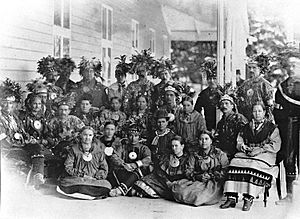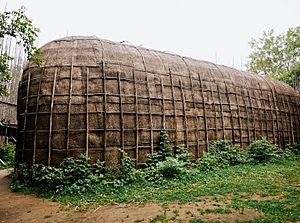Huron-Wendat Nation facts for kids
Quick facts for kids
Huron-Wendat Nation
|
|
|---|---|
| Nation Huronne-Wendat - Wendake | |
| Established | Huron-British Treaty of 1760 |
| Government | |
| • Type | Huron-Wendat Nation Council |
| Population | |
| • Total | 4,605 |
| Time zone | EDT DST |
| Website | https://wendake.ca/ |
The Huron-Wendat Nation is a group of Indigenous people who speak a language related to the Iroquois. They were first established in the 1600s. In French, which many members speak, they are called the Nation Huronne-Wendat. The French gave them the nickname "Huron," which meant "boar's head," because of how some Huron men styled their hair. The name "Wendat" (or Quendat) was their own name for themselves. It means "people of the island" or "dwellers on a peninsula."
Long ago, the Huron-Wendat lived in an area between Lake Simcoe and Georgian Bay. This place was known as Wendake (or Huronia). Today, their main communities are in Wendake, Quebec, Canada. This area is now part of Quebec City.
An important agreement, the 1760 Huron-British North American Peace Treaty, was found again in the 1990s. It showed that a large piece of land called "Seigneurie de Sillery" (now part of Quebec City) was sold to the Huron-Wendat in 1760. Because of this, the Huron-Wendat Nation has a claim to this land today.
Tourism is a big part of the economy in Wendake today. There is a historic area, homes, and businesses. As of April 2022, about 4,578 members of the Huron-Wendat Nation lived in Wendake, Quebec.
Contents
Huron-Wendat History
In the late 1500s, the Wendat Confederacy was formed. This was a group of allied nations who came together to defend themselves against the Iroquois Confederacy. The Wendat Confederacy included four main groups: the Attinniaoenten (Bear), Atingeennonniahak (Cords), Arendaenronnon (Rock), and Atahontaenrat (Deer). There was also another group, the Ataronchronon (Bog), who might have been part of the Bear group.
Between 1648 and 1650, the Wendat Confederacy faced a tough time. New diseases brought by Europeans, like measles and smallpox, greatly reduced their population. They also had fewer firearms than the Iroquois. Because of these challenges, the Iroquois Confederacy defeated the Wendat Confederacy. After this, some Huron people joined with the Tionontati tribe. Together, they formed the Wyandot, which is a different way of saying "Wendat."
On August 27, 1999, the Wendat Confederacy was officially brought back together. Four groups signed a document to reaffirm their connection. These groups were the Wyandotte Nation of Oklahoma (United States), the Wyandot Nation of Kansas (United States), the Wyandot of Anderdon Nation (Michigan, U.S.), and the Huron-Wendat of Wendake (Quebec, Canada).
Population and Language
How Many Huron-Wendat People Are There?
Before the 1500s, there were about 20,000 to 25,000 Huron-Wendat people. However, between 1634 and 1642, diseases from Europe, such as measles, influenza, and smallpox, caused their population to drop a lot. It went down to about 9,000 people. Today, as of April 2022, there are 4,578 registered members of the Huron-Wendat Nation in Wendake, Quebec.
In the United States, about 5,900 people identify as Wyandot or Wyandotte. They are members of the Wyandotte Nation, which has its main office in Wyandotte, Oklahoma.
The Wendat Language
The Wendat language, also known as Huron, was spoken by the Huron-Wendat Nation in Quebec, Canada, and parts of Oklahoma in the United States. It was the traditional language of the Wyandot, Wyandotte, or Huron people. This language is closely related to the Iroquois language family.
Wyandot (sometimes called Wandat) is a sister language to Wendat. Some language experts see it as a different way of speaking Wendat or a more modern version. It is mostly used in Oklahoma, United States.
By the late 1800s, the Wendat language had no living speakers. It was considered a "sleeping" language. However, in the 1970s and 1980s, people started trying to bring it back to life. They used old dictionaries and writings from missionaries. In 2010, the Wendat Community of Quebec and the Wyandot Nation of Oklahoma began teaching Wendat and Wyandot to their community members.
Huron-Wendat Government and Society
How the Huron-Wendat Governed Themselves
The Huron-Wendat government system had three main levels: village, tribe, and confederacy. In each village, there were several chiefs. These chiefs represented different clans, and each chief had a different role, like a civil chief or a war chief. Many of these roles were passed down through families. However, people could also earn these positions or be chosen by older women in their family line.
Chiefs held council meetings to talk about issues in the village. Both men and women were welcome to share their ideas at these meetings. The Huron-Wendat Confederacy also held a big meeting once a year.
Social Organization
The Wendats had a matrilineal society. This means that important things like status and property were passed down through the women in the family. Clan membership and positions could also be inherited this way.
Clan System
Like other Iroquois nations, the Wendat society used a matrilineal clan system. Clans were named after animals. The Huron had eight main clans: Turtle, Wolf, Bear, Beaver, Deer, Hawk, Porcupine, and Snake. To keep everyone connected, people in the same clan were seen as related, no matter which nation or village they belonged to. Because of this, people had to marry someone from a different clan.
Huron-Wendat Economy
A large part of the land where the Huron-Wendat Nation lived was good for farming. This area was north and west of Lake Simcoe and south and east of Georgian Bay. Because of this, most Huron-Wendat people were farmers. Their economy was based on growing crops like maize (corn), beans, and squash.
Huron-Wendat Culture
Traditional Housing
Like other Iroquoian-speaking people, the Huron built longhouses. These houses were rectangular with rounded roofs covered by bark panels. Longhouses were built to be homes for both small and large families.
Clothing and Style
Wendat clothing was mostly made from deer and beaver hides. Their clothes were often very decorated with porcupine quills, feathers, and wampum beads. Red was a very popular color in their culture.
Men wore loincloths and moccasins on their feet. In the winter, they added sleeves and cloaks made of fur. They often carried small pouches on their backs. These pouches held things like tobacco pipes, good luck charms, and other personal items. Wendat men often smoked pipes, so carrying one was common. Women wore similar clothing to men, but they wore skirts instead of loincloths.
Media
Books About the Huron-Wendat
The book Revisiting 1759 was written by Thomas Peace and published in 2012. In one chapter, Peace discusses how the Huron-Wendat Nation reacted to the big changes that happened during the conquest of Quebec, from 1697 to 1791.




